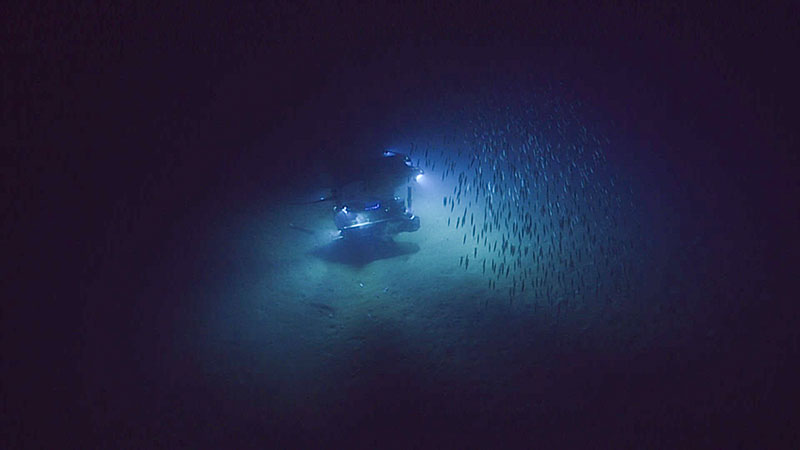
by Meagan Putts, Biology Lead, University of Hawaii
September 14, 2019

The shallowest depth that the ROV Deep Discoverer dives at is 250 meters, below the depth that severe storms have been measured to cause disturbances. Image courtesy of the NOAA Office of Ocean Exploration and Research, Deep Connections 2019. Download larger version (jpg, 592 KB).
As Hurricane Dorian started making its way north, many of us aboard NOAA Ship Okeanos Explorer were not surprised to hear that we would have to cancel a few remotely operated vehicle (ROV) dives in order to seek shelter at our home port in North Kingston, Rhode Island. Hurricanes like Dorian are extremely powerful storms that can cause severe damage to coastal ecosystems and manmade infrastructure alike. Hurricane Dorian caused tragic loss of life and tremendous damage in the Bahamas as a Category 5 hurricane. As it continued towards the southeastern United States, its strength lessened, though it still managed to wreak havoc for many. Such storm conditions would not only impede scientific operations aboard NOAA Ship Okeanos Explorer, but could potentially also be unsafe. As such, the decision to head into port to weather the storm was a fairly straightforward one.
One question that frequently comes up is what happens to deep-sea ecosystems during such a large storm event. While the physical effects of hurricanes on near-shore ecosystems, such as shallow-water coral reefs and estuaries are well documented, little research has been conducted on the direct impacts of hurricanes on the deep sea. Due to its remote nature, observations of the deep sea are scarce, and even more so after extreme weather events like a hurricane.
The churning of waves and strong winds which can have strong influences on shallow-water ecosystems, are felt much less profoundly by the deep-sea animals that we encounter during our ROV dives. In fact, measurable disturbances of a hurricane only reach a maximum depth of about 90 meters (~300 feet) below the surface—the approximate height of the Statue of Liberty. For reference, the shallowest depth that ROV Deep Discoverer dives is 250 meters (~820 feet), with a maximum diving depth of 6,000 meters (~19,685 feet).
However, there may be an unexpected benefit for deep-sea life after the storm passes. As a hurricane moves across the ocean, the force of the storm churns up water, mixing warmer water at the surface with cooler, nutrient rich water from farther down in the water column, in a process known as upwelling. Upwelling is a powerful force that can help drive food production in the ocean. The deep waters it brings to the surface provide nutrients to phytoplankton, the primary producers that make most of the food in the ocean. With plenty of nutrients to fuel photosynthesis, phytoplankton will bloom, in turn providing food for other organisms. Generally, only a small fraction of the organic matter produced by phytoplankton and the organisms that feed on them at the surface makes its way to the seafloor as a food source for the animals that live there. This is because much of this food is recycled and retained within the photic zone, the shallow waters where phytoplankton live. However, just like when you cook too much food for an event, a big plankton bloom can lead to a lot of leftovers, and this excess of organic matter will then sink to the waters below, providing food for deep-sea animals.